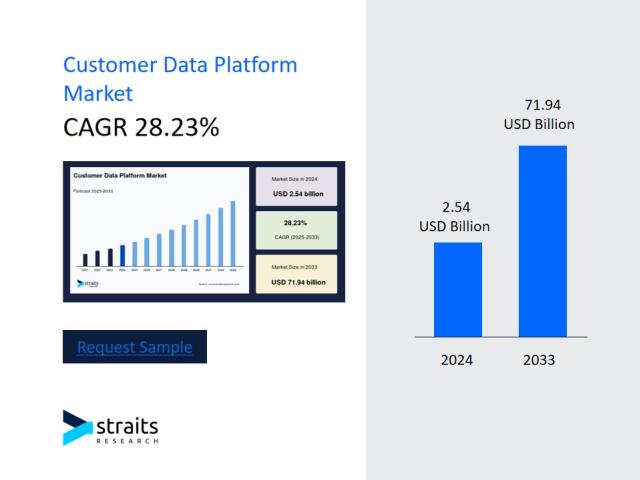In today's fast-paced digital world, businesses are increasingly relying on data to drive decision-making, optimize operations, and fuel growth. The management of data centers, where vast amounts of information are stored and processed, has become a critical component of modern business strategy.
This article explores how cutting-edge data infrastructure and enterprise analytics are revolutionizing data center management and driving business growth.
The Importance of Data Infrastructure in Business Growth
Data infrastructure refers to the foundational technologies and systems that enable the storage, processing, and analysis of data. It includes hardware, software, networking equipment, and data management practices that support the entire lifecycle of data within an organization. As businesses generate and collect more data than ever before, the importance of robust data infrastructure cannot be overstated.
Scalability and Flexibility
As businesses grow, so do their data needs. A scalable data infrastructure allows organizations to expand their data storage and processing capabilities without significant disruptions.
This flexibility ensures that businesses can accommodate increasing data volumes and adapt to changing demands.
For example, cloud-based data infrastructure solutions offer businesses the ability to scale resources up or down based on demand. This elasticity is crucial for companies experiencing rapid growth or fluctuating workloads.
Data Security and Compliance
Protecting sensitive data is a top priority for businesses, especially in industries with strict regulatory requirements.
A well-designed data infrastructure includes robust security measures such as encryption, access controls, and regular audits to safeguard data from unauthorized access and breaches.
Compliance with regulations like the General Data Protection Regulation (GDPR) or the Health Insurance Portability and Accountability Act (HIPAA) is essential for avoiding costly fines and reputational damage.
Data infrastructure that supports compliance helps businesses meet these requirements.
Optimized Data Processing and Storage
Efficient data processing and storage are critical for maintaining high performance in data-driven applications. Modern data infrastructure solutions, such as high-performance computing (HPC) clusters and distributed storage systems, enable businesses to process large datasets quickly and store them in a cost-effective manner.
By optimizing data processing and storage, businesses can reduce latency, improve application performance, and lower operational costs.
This optimization is particularly important for industries that rely on real-time data processing, such as finance and healthcare.
Enhanced Data Accessibility and Collaboration
In today's interconnected world, businesses need to enable seamless data access and collaboration across teams and departments. A modern data infrastructure supports this by providing secure, centralized access to data from anywhere in the world.
Collaborative tools and platforms that integrate with data infrastructure allow teams to work together more effectively, share insights, and make data-driven decisions.
This increased accessibility and collaboration lead to faster innovation and better business outcomes.
The Role of Enterprise Analytics in Business Growth
Enterprise analytics involves the use of data analysis tools and techniques to gain insights into business operations, customer behavior, and market trends.
By leveraging data analytics, businesses can make informed decisions that drive growth, improve efficiency, and enhance customer experiences.
Data-Driven Decision Making
One of the most significant benefits of enterprise analytics is its ability to support data-driven decision-making. By analyzing historical data and real-time information, businesses can identify patterns, trends, and correlations that inform strategic decisions.
For example, a retail company might use enterprise analytics to analyze customer purchase history and predict future buying behavior. This insight can inform inventory management, marketing campaigns, and pricing strategies, ultimately driving sales and profitability.
Operational Efficiency
Enterprise analytics helps businesses identify inefficiencies and areas for improvement in their operations.
By analyzing data from various sources, such as supply chain management systems, production lines, and customer service platforms, businesses can pinpoint bottlenecks and streamline processes.
For instance, a manufacturing company might use analytics to monitor equipment performance and predict maintenance needs. By proactively addressing potential issues, the company can reduce downtime, improve productivity, and lower maintenance costs.
Customer Insights and Personalization
Understanding customer behavior is crucial for businesses looking to enhance the customer experience and drive loyalty. Enterprise analytics provides businesses with deep insights into customer preferences, purchasing habits, and feedback.
By leveraging this data, businesses can create personalized marketing campaigns, tailor product offerings, and improve customer service. Personalization not only increases customer satisfaction but also boosts sales and long-term customer retention.
Predictive and Prescriptive Analytics
Predictive analytics uses historical data and machine learning algorithms to forecast future outcomes, while prescriptive analytics recommends specific actions based on those predictions.
These advanced analytics techniques enable businesses to anticipate market trends, optimize operations, and mitigate risks.
For example, a financial institution might use predictive analytics to forecast market movements and adjust its investment strategies accordingly. By staying ahead of market trends, the institution can maximize returns and minimize losses.
Revolutionizing Data Center Management with Data Infrastructure and Enterprise Analytics
Data centers are the backbone of modern businesses, providing the necessary infrastructure to store, process, and manage vast amounts of data. As the volume of data continues to grow, data center management has become increasingly complex.
However, cutting-edge data infrastructure and enterprise analytics are revolutionizing how data centers operate, leading to improved efficiency, reliability, and scalability.
Automated Data Center Operations
One of the most significant advancements in data center management is the automation of routine tasks and processes.
By integrating advanced data infrastructure with enterprise analytics, data centers can automate tasks such as resource allocation, load balancing, and system monitoring.
Automation reduces the need for manual intervention, minimizes human error, and increases operational efficiency. For example, an automated data center can dynamically allocate resources based on real-time demand, ensuring optimal performance and energy efficiency.
Real-Time Monitoring and Predictive Maintenance
Data centers rely on continuous monitoring to ensure the health and performance of critical infrastructure. By leveraging enterprise analytics, data centers can monitor key performance indicators (KPIs) in real time and identify potential issues before they escalate.
Predictive maintenance, powered by analytics, enables data centers to anticipate equipment failures and schedule maintenance proactively.
This approach reduces unplanned downtime, extends the lifespan of equipment, and lowers maintenance costs.
Energy Efficiency and Sustainability
As data centers consume significant amounts of energy, improving energy efficiency is a top priority. Advanced data infrastructure and analytics play a crucial role in optimizing energy usage and reducing the environmental impact of data centers.
Analytics-driven insights allow data centers to optimize cooling systems, manage power consumption, and implement energy-efficient practices.
For example, machine learning algorithms can predict temperature fluctuations and adjust cooling systems accordingly, reducing energy waste.
Scalability and Resource Optimization
Data centers must be able to scale their resources to meet the growing demands of businesses. Modern data infrastructure, combined with enterprise analytics, enables data centers to scale their operations efficiently while optimizing resource utilization.
For instance, cloud-based data centers can leverage analytics to predict future demand and allocate resources accordingly. This approach ensures that data centers can handle peak loads without over-provisioning resources, leading to cost savings and improved performance.
Enhanced Security and Compliance
Security is a critical concern for data centers, especially given the increasing number of cyber threats. Enterprise analytics can enhance data center security by analyzing network traffic, detecting anomalies, and identifying potential security breaches.
Additionally, analytics can help data centers comply with regulatory requirements by monitoring and reporting on data access, usage, and storage practices.
This proactive approach to security and compliance helps data centers protect sensitive information and avoid costly penalties.
Case Studies: Real-World Examples of Data Infrastructure and Analytics in Data Center Management
To illustrate the impact of cutting-edge data infrastructure and enterprise analytics on data center management, let's explore a few real-world case studies.
Case Study 1: A Global Financial Institution
A global financial institution faced challenges in managing its data center operations across multiple regions. The institution implemented a data infrastructure solution that integrated real-time analytics and automation tools to streamline operations.
By leveraging predictive analytics, the institution was able to anticipate equipment failures and schedule maintenance proactively. This approach reduced downtime by 30% and improved overall system reliability.
Additionally, the institution used analytics to optimize resource allocation, resulting in a 20% reduction in energy consumption. This energy efficiency not only lowered operational costs but also aligned with the institution's sustainability goals.
Case Study 2: A Leading E-Commerce Company
A leading e-commerce company experienced rapid growth, leading to increased demand for data storage and processing capabilities. The company implemented a scalable data infrastructure solution that combined cloud-based storage with advanced analytics.
By using enterprise analytics, the company was able to monitor customer behavior in real time and adjust its marketing strategies accordingly. This data-driven approach resulted in a 15% increase in sales and improved customer satisfaction.
The company's data center also leveraged predictive maintenance to ensure the continuous operation of critical systems during peak shopping periods. This proactive maintenance approach minimized downtime and enhanced the customer experience.
Case Study 3: A Healthcare Provider
A healthcare provider needed to improve the efficiency and security of its data center operations while ensuring compliance with strict regulatory requirements.
The provider implemented a data infrastructure solution that integrated enterprise analytics for real-time monitoring and security.
By using analytics to monitor network traffic and detect anomalies, the provider was able to prevent potential security breaches and protect sensitive patient data. This enhanced security posture helped the provider comply with regulations such as HIPAA and avoid costly penalties.
Additionally, the provider used analytics to optimize resource utilization, resulting in a 25% reduction in operational costs. The cost savings allowed the provider to invest in new technologies and improve patient care.
The Future of Data Center Management: Trends and Innovations
The landscape of data center management is continuously evolving, driven by advancements in technology and the growing demands of businesses.
As we look to the future, several key trends and innovations are expected to shape the way data centers operate.
Edge Computing and Distributed Data Centers
Edge computing is an emerging trend that involves processing data closer to the source of data generation, rather than in centralized data centers. This approach reduces latency and improves the performance of applications that require real-time processing.
As businesses adopt edge computing, data centers will become more distributed, with smaller facilities located closer to end-users. This shift will require data centers to implement scalable and flexible data infrastructure solutions that can support distributed operations.
AI and Machine Learning in Data Center Management
Artificial intelligence (AI) and machine learning are increasingly being used to optimize data center operations. These technologies enable data centers to analyze vast amounts of data, identify patterns, and make data-driven decisions in real time.
For example, AI-powered analytics can predict equipment failures, optimize energy usage, and enhance security by detecting potential threats. As AI and machine learning continue to advance, their role in data center management will only grow.
Sustainable Data Center Practices
Sustainability is becoming a top priority for businesses and data centers alike. As data centers consume significant amounts of energy, there is a growing focus on implementing sustainable practices to reduce their environmental impact.
Innovations such as liquid cooling, renewable energy sources, and energy-efficient hardware are being adopted by data centers to improve sustainability. Additionally, data centers are using analytics to monitor and optimize energy usage, further reducing their carbon footprint.
Hybrid and Multi-Cloud Environments
As businesses adopt hybrid and multi-cloud strategies, data centers must adapt to support these complex environments.
Hybrid cloud solutions combine on-premises infrastructure with public and private clouds, offering businesses greater flexibility and scalability.
Data centers will need to implement advanced data infrastructure solutions that enable seamless integration and management of hybrid and multi-cloud environments. This trend will drive the adoption of cloud-native technologies and analytics platforms that can manage diverse workloads.
Conclusion: Embracing the Future of Data Center Management
The integration of cutting-edge data infrastructure and enterprise analytics is revolutionizing data center management, leading to improved efficiency, scalability, and business growth.
As businesses continue to rely on data to drive decision-making and innovation, the role of data centers will only become more critical.
By embracing these advancements, businesses can unlock new opportunities, optimize their operations, and stay ahead of the competition. The future of data center management is bright, with continued innovation and the adoption of emerging technologies paving the way for even greater success.
For businesses looking to stay at the forefront of this transformation, partnering with experts in data center management and analytics is essential.
At Reboot Monkey, we specialize in helping businesses harness the power of data infrastructure and analytics to achieve their growth goals.
Contact us today to learn how we can support your data center management needs and drive your business forward.



















